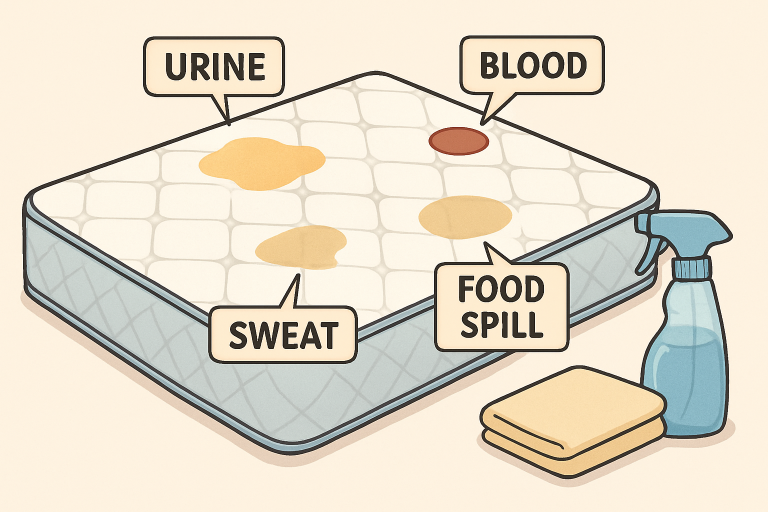Keeping your mattress clean is not just about appearances—it’s about creating a healthy, restful space to recharge every night. Over time, all kinds of stains can develop, from sweat to food spills, making the sleeping environment less inviting and increasing wear on your mattress. Whether you’re dealing with common messes or unexpected accidents, knowing the right steps for removing urine stains and other stubborn spots can help you protect your investment and enjoy consistently better sleep.
Mattress stains can foster bacteria, odors, and allergens, negatively affecting sleep quality and overall health. Prompt and proper cleaning extends your mattress’s lifespan and ensures your bedroom remains a sanctuary for restorative rest. Taking the right approach to stain removal keeps your sleeping area fresh, comfortable, and clear of potentially harmful irritants.
Early intervention is always best, especially when dealing with persistent stains like blood or bodily fluids, which can be difficult to remove if left untreated. Preventive steps, regular cleaning, and spot-specific techniques are key to avoiding set-in marks and maintaining the integrity of your mattress. By following proven cleaning guidelines, you can prevent tough stains from becoming permanent—and sleep more soundly every night.
Table of Contents
Common Types of Mattress Stains
Identifying the origin of a mattress stain is essential for successful removal. Different substances call for specific cleaning methods, and home remedies work best when matched to the mess:
- Urine: Most frequently caused by bedwetting or pet accidents—urine contains bacteria and leaves a persistent odor if not treated quickly.
- Blood: Common due to injuries, nosebleeds, or menstrual leaks. Blood stains are stubborn and can set rapidly if not treated properly.
- Sweat: Over months or years, sweat soaks through sheets, causing yellowing and sometimes a musty smell that signals mildew or bacteria growth.
- Food and Drink: Eating or drinking in bed can lead to spills from coffee, wine, juice, or greasy foods, which can leave behind colored, sticky stains and odors.

General Cleaning Steps
Preparation is the foundation for effective spot removal and can make the difference between a quick fix and a lingering blot:
- Strip the Bed: Remove all sheets, mattress protectors, and pillowcases and wash them separately in warm water.
- Vacuum the Mattress: Using the upholstery attachment, vacuum the mattress surface, focusing on seams and corners where dirt and allergens collect.
- Spot Test: Always test your chosen cleaning solution on a small, hidden mattress section to ensure it won’t cause discoloration or damage.
Specific Stain Removal Techniques
Urine Stains
Getting rid of urine stains and odors is crucial for hygiene and comfort. Here’s a time-tested process:
- Blot the Area: Press a clean, dry cloth firmly on the stain to absorb as much liquid as possible—never rub, as this spreads the mess.
- Apply a Cleaning Solution: Mix one cup of hydrogen peroxide, three tablespoons of baking soda, and a few drops of liquid dish soap. Spray or dab this onto the spot and let it sit for 10 minutes.
- Blot and Dry: Use a fresh cloth to blot up the solution, then allow the mattress to air dry thoroughly before making the bed again.
Blood Stains
Quick action prevents blood stains from setting, which makes removal much easier:
- Use Cold Water: Blot the site gently with a cloth soaked in cold water; hot water may cause the proteins in blood to bind to the fibers, making stains harder to remove.
- Apply Hydrogen Peroxide: Pour a small amount directly on the stain—expect fizzing. Dab at the stain with a clean cloth until the discoloration lifts.
- Rinse and Dry: Use another cloth moistened with cold water to remove any remnants of hydrogen peroxide. Air dry.
Sweat Stains
Chronic sweat stains manifest as yellow patches and unpleasant odors:
- Prepare a Cleaning Paste: Mix equal parts baking soda and water to create a spreadable paste.
- Apply the Paste: Spread it thickly over the affected area and allow it to stand for at least 30 minutes.
- Vacuum the Residue: Once dry, vacuum the surface with a clean attachment to lift the baking soda residue.
Food and Drink Stains
Foods and beverages should be cleaned up as soon as possible to avoid permanent marks:
- Blot the Spill: Absorb as much liquid as possible with a dry towel or cloth.
- Apply a Mild Detergent Solution: Combine a few drops of dish soap with water. Dab into the stain and gently blot to remove food or drink residue.
- Rinse and Dry: Blot with a clean, damp towel to remove soap, then let the area dry completely before sleeping on it again.
Preventive Measures
Prevention is always easiest, and a few simple routines help keep mattresses cleaner for longer:
- Use a Mattress Protector: A waterproof, removable mattress cover shields against spills and absorbs sweat.
- Regular Cleaning: Vacuum your mattress and launder bedding monthly to curb dust mites and allergen accumulation.
- Avoid Eating in Bed: Limiting meals and beverages greatly reduces the risk of food and drink stains.
When to Seek Professional Help
If stubborn stains remain despite your best efforts, or if odors persist, professional cleaners have the tools and expertise to salvage your mattress. They use specialized cleaning agents and equipment that go deeper than DIY solutions, rejuvenating your sleep surface and helping you maximize your mattress investment. Professional cleaning may be the safest choice for especially valuable or delicate mattresses, or in cases of significant water or mold damage.
For further guidance on maintaining a healthy sleep environment and preventing persistent bedroom allergens, consider understanding better ways to reduce indoor irritants and safeguard your sleep quality long-term.
Following these tips can make mattress cleaning more manageable and far less daunting. Consistent care not only improves the cleanliness of your bed but also fosters deeper, more restorative sleep—night after night.
